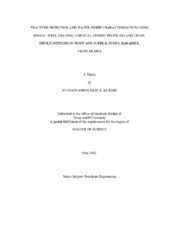| dc.contributor.advisor | Schechter, David S. | |
| dc.creator | Aljeshi, Hussain Abdulhadi A. | |
| dc.date.accessioned | 2012-07-16T15:57:36Z | |
| dc.date.accessioned | 2012-07-16T20:22:43Z | |
| dc.date.available | 2014-09-16T07:28:21Z | |
| dc.date.created | 2012-05 | |
| dc.date.issued | 2012-07-16 | |
| dc.date.submitted | May 2012 | |
| dc.identifier.uri | https://hdl.handle.net/1969.1/ETD-TAMU-2012-05-10360 | |
| dc.description.abstract | This work was conducted to help understand a premature and irregular water breakthrough which resulted from a waterflooding project in the increment II region of Haradh oilfield in Saudi Arabia using different geophysical methods. Oil wells cannot sustain the targeted oil production rates and they die much sooner than expected when water enters the wells. The study attempted to identify fracture systems and their role in the irregular water sweep. Single-well acoustic migration imaging (SWI), walkaround vertical seismic profiling (VSP) and cross-dipole shear wave measurements were used to detect anisotropy caused by fractures near and far from the borehole. The results from all the different methods were analyzed to understand the possible causes of water fingering in the field and determine the reasons for discrepancies and similarities of results of the different methods. The study was done in wells located in the area of the irregular water encroachment in Haradh II oilfield. Waterflooding was performed, where water was injected in the water injector wells drilled at the flanks of Harahd II toward the oil producer wells. Unexpected water coning was noticed in the west flank of the field. While cross-dipole and SWI measurements of a small-scale clearly identify a fracture oriented N60E in the upper tight zone of the reservoir, the VSP measurements of a large-scale showed a dominating fracture system to the NS direction in the upper highpermeability zone of the same reservoir. These results are consistent with the directions of the three main fracture sets in the field at N130E, N80E and N20E, and the direction of the maximum horizontal stress in the field varies between N50E and N90E. Results suggested that the fracture which is detected by cross-dipole at 2 to 4 ft from the borehole is the same fracture detected by SWI 65 ft away from the borehole. This fracture was described using the SWI as being 110 ft from top to bottom, having an orientation of N60E and having an angle of dip of 12° relative to the vertical borehole axis. The detected fracture is located in the tight zone of the reservoir makes a path for water to enter the well from that zone. On the Other hand, the fractures detected by the large-scale VSP measurements in the NS direction are responsible for the high-permeability in the upper zone of the reservoir. | en |
| dc.format.mimetype | application/pdf | |
| dc.language.iso | en_US | |
| dc.subject | Fracture Detection | en |
| dc.subject | Single-well Imaging | en |
| dc.subject | Vertical Seismic Profiling | en |
| dc.subject | Cross- dipole Methods Tight | en |
| dc.subject | Super-K | en |
| dc.subject | Haradh II | en |
| dc.subject | Saudi Arabia | en |
| dc.title | Fracture Detection and Water Sweep Characterization Using Single-well Imaging, Vertical Seismic Profiling and Cross-dipole Methods in Tight and Super-k Zones, Haradh II, Saudi Arabia | en |
| dc.type | Thesis | en |
| thesis.degree.department | Petroleum Engineering | en |
| thesis.degree.discipline | Petroleum Engineering | en |
| thesis.degree.grantor | Texas A&M University | en |
| thesis.degree.name | Master of Science | en |
| thesis.degree.level | Masters | en |
| dc.contributor.committeeMember | Ayers, Walter B. | |
| dc.contributor.committeeMember | Gibson, Richard L. | |
| dc.type.genre | thesis | en |
| dc.type.material | text | en |
| local.embargo.terms | 2014-07-16 | |


